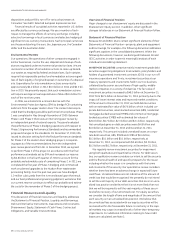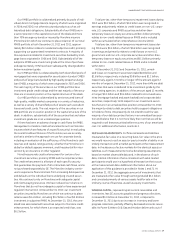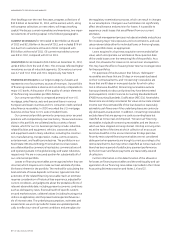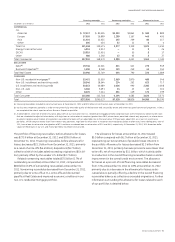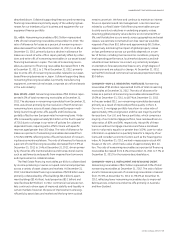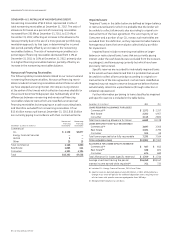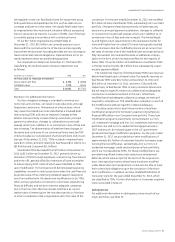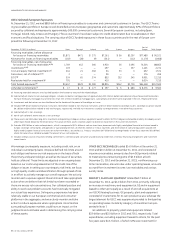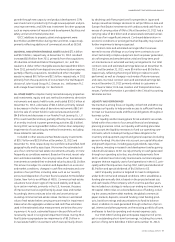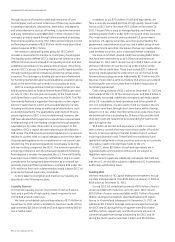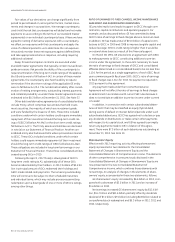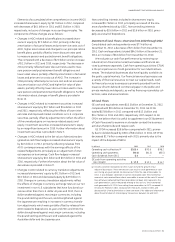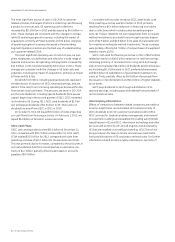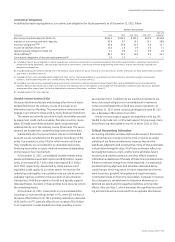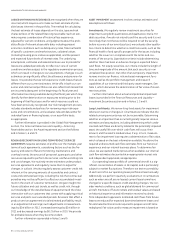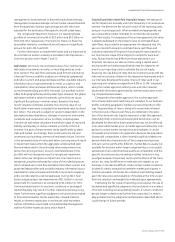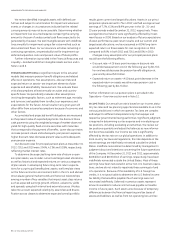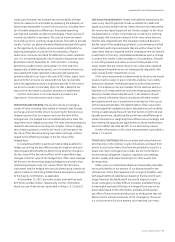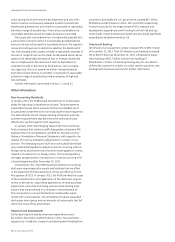GE 2012 Annual Report Download - page 60
Download and view the complete annual report
Please find page 60 of the 2012 GE annual report below. You can navigate through the pages in the report by either clicking on the pages listed below, or by using the keyword search tool below to find specific information within the annual report.management’s discussion and analsis
58 GE 2012 ANNUAL REPORT
through issuance of long-term debt and reissuance of com-
mercial paper, cash on hand, collections of financing receivables
exceeding originations, dispositions, asset sales, and deposits
and other alternative sources of funding. Long-term maturities
and early redemptions were $88 billion in 2012. Interest on bor-
rowings is primarily repaid through interest earned on existing
financing receivables. During 2012, GECC earned interest income
on financing receivables of $21.0 billion, which more than offset
interest expense of $11.7 billion.
We maintain a detailed liquidity policy for GECC which
includes a requirement to maintain a contingency funding plan.
The liquidity policy defines GECC’s liquidity risk tolerance under
different stress scenarios based on its liquidity sources and also
establishes procedures to escalate potential issues. We actively
monitor GECC’s access to funding markets and its liquidity profile
through tracking external indicators and testing various stress
scenarios. The contingency funding plan provides a framework
for handling market disruptions and establishes escalation proce-
dures in the event that such events or circumstances arise.
GECC is a savings and loan holding company under U.S. law
and became subject to Federal Reserve Board (FRB) supervision
on July 21, 2011, the one-year anniversary of the Dodd-Frank
Wall Street Reform and Consumer Protection Act (DFA). The FRB
has recently finalized a regulation that requires certain organi-
zations it supervises to submit annual capital plans for review,
including institutions’ plans to make capital distributions, such
as dividend payments. The applicability and timing of this pro-
posed regulation to GECC is not yet determined; however, the
FRB has indicated that it expects to extend these requirements
to large savings and loan holding companies through separate
rulemaking or by order. While GECC is not yet subject to this
regulation, GECC’s capital allocation planning is still subject to
FRB review. The FRB recently proposed regulations to revise and
replace its current rules on capital adequacy and we have taken
the proposed regulations into consideration in our current capi-
tal planning. The proposed regulations would apply to savings
and loan holding companies like GECC. The transition period for
achieving compliance with the proposed regulations following
final adoption is unclear. As expected, the U.S. Financial Stability
Oversight Council (FSOC) recently notified GECC that it is under
consideration for a proposed determination as a nonbank sys-
temically important financial institution (nonbank SIFI) under the
DFA. While not final, such a determination would subject GECC to
proposed enhanced supervisory standards.
Actions taken to strengthen and maintain our liquidity are
described in the following sections.
Liquidity Sources
We maintain liquidity sources that consist of cash and equiva-
lents and a portfolio of high-quality, liquid investments and
committed unused credit lines.
We have consolidated cash and equivalents of $77.4 billion at
December 31, 2012, which is available to meet our needs. Of this,
approximately $16 billion is held at GE and approximately $62 bil-
lion is held at GECC.
In addition to our $77.4 billion of cash and equivalents, we
have a centrally managed portfolio of high-quality, liquid invest-
ments at GECC with a fair value of $3.1 billion at December 31,
2012. This portfolio is used to manage liquidity and meet the
operating needs of GECC under both normal and stress scenarios.
The investments consist of unencumbered U.S. government
securities, U.S. agency securities, securities guaranteed by the
government, supranational securities, and a select group of non-
U.S. government securities. We believe that we can readily obtain
cash for these securities, even in stressed market conditions.
We have committed, unused credit lines totaling $48.2 billion
that have been extended to us by 51 financial institutions at
December 31, 2012. GECC can borrow up to $48.2 billion under all
of these credit lines. GE can borrow up to $12.0 billion under
certain of these credit lines. These lines include $30.3 billion of
revolving credit agreements under which we can borrow funds
for periods exceeding one year. Additionally, $17.9 billion are 364-
day lines that contain a term-out feature that allows us to extend
borrowings for one or two years from the date of expiration of
the lending agreement.
Cash and equivalents of $53.2 billion at December 31, 2012 are
held outside of the U.S. Of this amount at year-end, $14.4 billion is
indefinitely reinvested. Indefinitely reinvested cash held outside
of the U.S. is available to fund operations and other growth of
non-U.S. subsidiaries; it is also used to fund our needs in the U.S.
on a short-term basis through short-term loans, without being
subject to U.S. tax. Under the Internal Revenue Code, these loans
are permitted to be outstanding for 30 days or less and the total
of all such loans are required to be outstanding for less than 60
days during the year.
$1.8 billion of GE cash and equivalents is held in countries
with currency controls that may restrict the transfer of funds to
the U.S. or limit our ability to transfer funds to the U.S. without
incurring substantial costs. These funds are available to fund
operations and growth in these countries and we do not currently
anticipate a need to transfer these funds to the U.S.
At GECC, about $10 billion of cash and equivalents are in
regulated banks and insurance entities and are subject to
regulatory restrictions.
If we were to repatriate indefinitely reinvested cash held out-
side the U.S., we would be subject to additional U.S. income taxes
and foreign withholding taxes.
Funding Plan
We have reduced our GE Capital ending net investment, exclud-
ing cash and equivalents, from $513 billion at January 1, 2009 to
$419 billion at December 31, 2012.
During 2012, GE completed issuances of $7.0 billion of senior
unsecured debt with maturities up to 30 years. GECC issued
$33.9 billion of senior unsecured debt and $1.7 billion of secured
debt (excluding securitizations described below) with maturi-
ties up to 40 years (and subsequent to December 31, 2012, an
additional $13.1 billion). Average commercial paper borrowings
for GECC and GE during the fourth quarter were $40.4 billion
and $10.2 billion, respectively, and the maximum amounts of
commercial paper borrowings outstanding for GECC and GE
during the fourth quarter were $43.1 billion and $14.8 billion,


